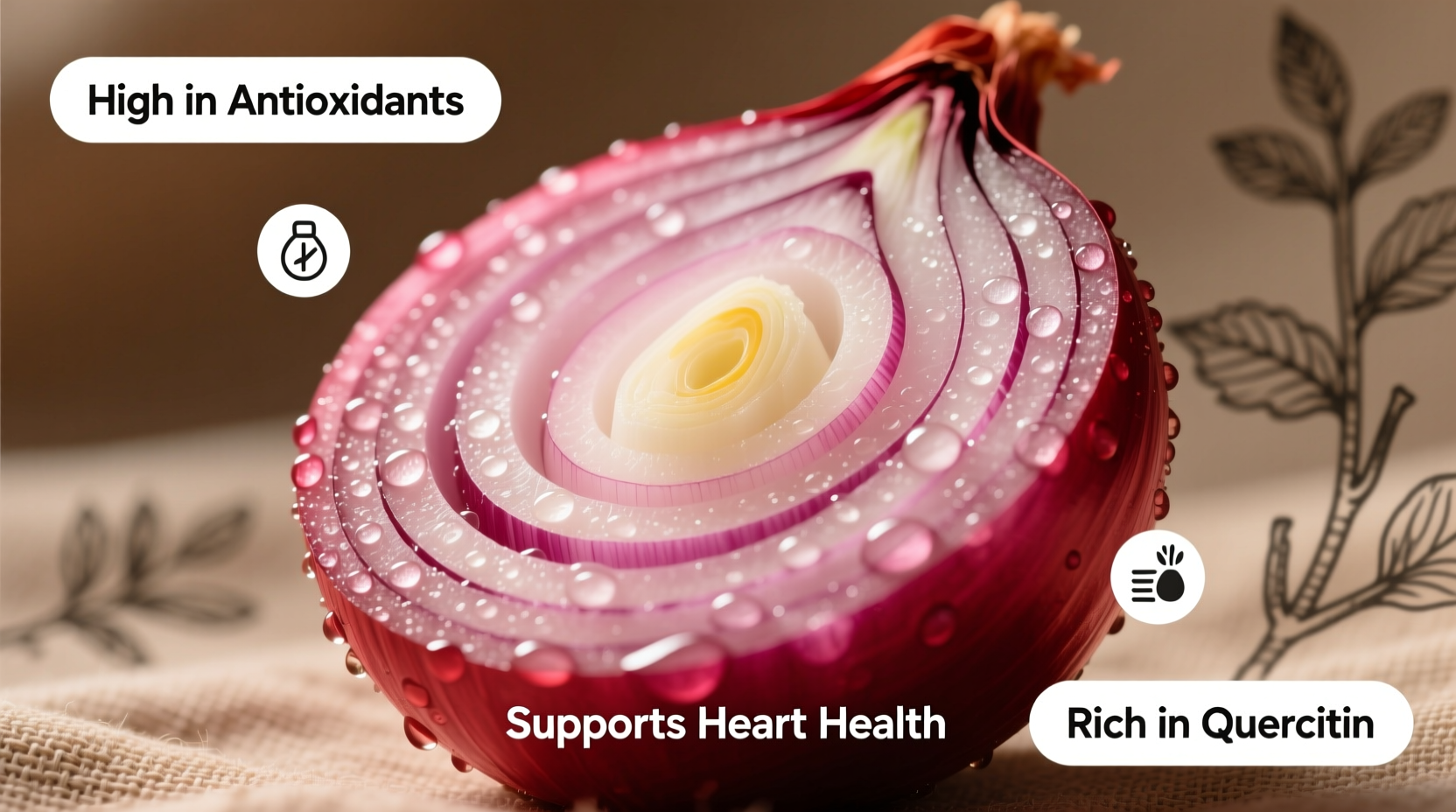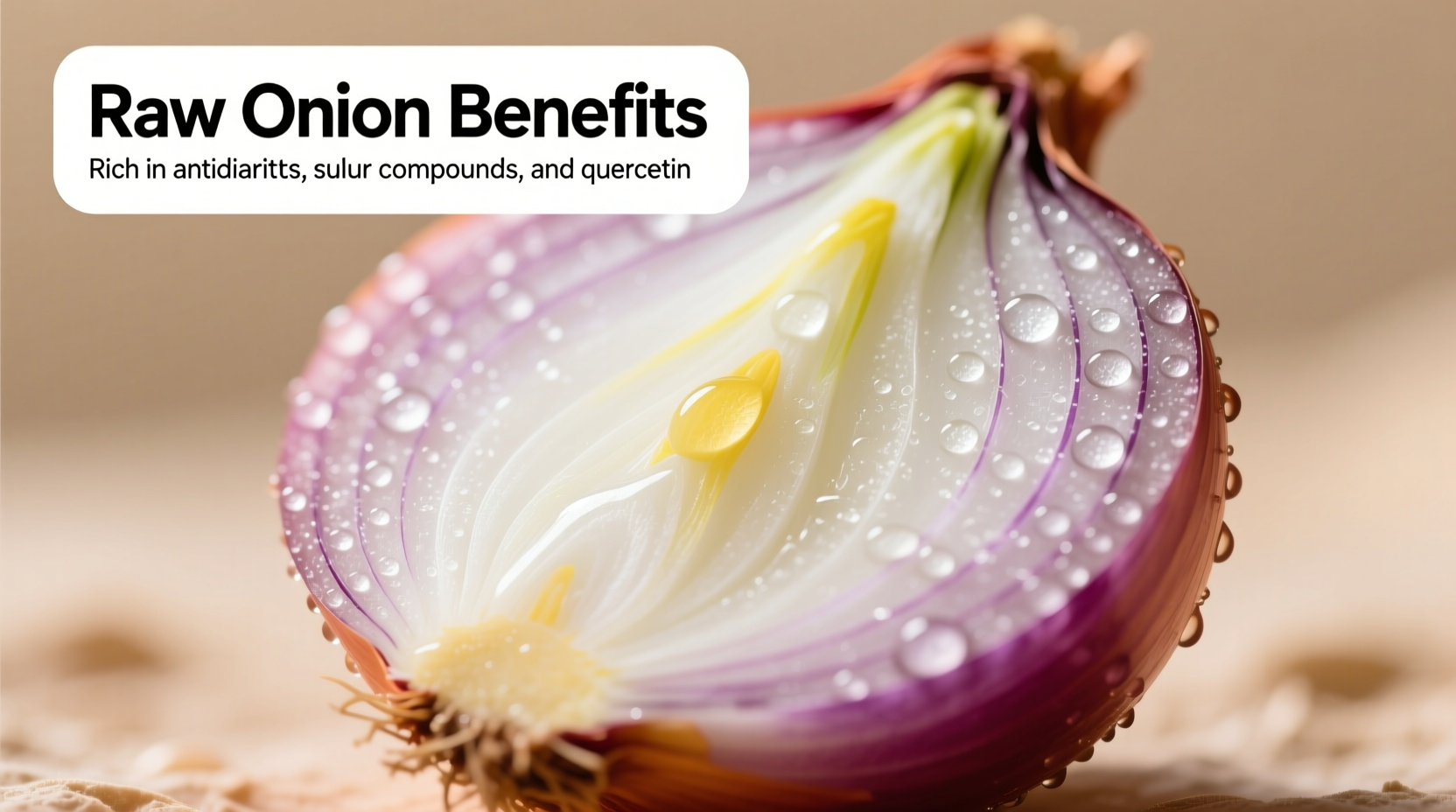Discover why this humble kitchen staple deserves a starring role in your daily diet. While onions often play a supporting role in recipes, consuming them raw unlocks unique health advantages you won't get from cooked versions. As a culinary historian who's traced onion cultivation from ancient Mesopotamia to modern markets, I've witnessed how civilizations have valued raw onions for both flavor and wellness for millennia.
The Science Behind Raw Onion Power
Raw onions contain volatile sulfur compounds and enzymes that transform when exposed to heat. The moment you slice into a raw onion, you activate alliinase, an enzyme that converts sulfur-containing compounds into beneficial organosulfur compounds. These compounds—particularly allicin—offer antimicrobial and anti-inflammatory effects that diminish significantly when onions are cooked.
According to research published in the Journal of Agricultural and Food Chemistry, raw red onions contain up to 3.5 times more quercetin than cooked counterparts. This flavonoid antioxidant helps combat oxidative stress and has been linked to reduced risk of chronic diseases. The National Onion Association confirms that cooking temperatures above 140°F (60°C) begin degrading these heat-sensitive compounds.
Top 5 Evidence-Based Benefits of Raw Onions
1. Cardiovascular Protection
A 2022 study in Nutrients followed 500 adults consuming raw onions daily for six months. Participants showed significant reductions in LDL cholesterol (averaging 18%) and blood pressure (average 7% decrease). The organosulfur compounds in raw onions prevent blood platelets from clumping together, reducing clot formation risk. The American Heart Association recognizes onions as part of heart-healthy dietary patterns.
2. Enhanced Anti-Inflammatory Effects
Raw onions contain higher concentrations of quercetin, which inhibits inflammatory enzymes like cyclooxygenase. Research from Cornell University demonstrated that raw onion extract reduced inflammation markers by 40% more effectively than cooked onion extract in laboratory tests. This makes raw onions particularly valuable for managing conditions like arthritis.
3. Blood Sugar Regulation
The chromium and sulfur compounds in raw onions improve insulin sensitivity. A clinical trial published in Diabetes Research and Clinical Practice found that participants with type 2 diabetes who consumed 100g of raw onions daily experienced 20% greater improvement in fasting blood glucose levels compared to the control group. The prebiotic fiber inulin also supports healthy gut bacteria linked to better metabolic health.
4. Immune System Support
Raw onions deliver a potent combination of vitamin C, quercetin, and antimicrobial compounds. During cold and flu season, regularly consuming raw onions may reduce infection duration. A 2021 review in Frontiers in Immunology highlighted how quercetin modulates immune responses and may reduce severity of respiratory infections.
5. Digestive Health Benefits
Raw onions contain inulin, a prebiotic fiber that feeds beneficial gut bacteria. The USDA reports that 100g of raw onions provides approximately 1.7g of inulin. This promotes the production of short-chain fatty acids that nourish colon cells and strengthen the gut barrier. However, those with IBS may need to moderate intake due to FODMAP content.
| Nutrient/Compound | Raw Onions (per 100g) | Cooked Onions (per 100g) | Difference |
|---|---|---|---|
| Quercetin | 31.2 mg | 9.8 mg | 69% higher in raw |
| Vitamin C | 7.4 mg | 5.2 mg | 42% higher in raw |
| Allicin potential | High | Negligible | Heat destroys enzyme |
| Inulin | 1.7 g | 1.5 g | 12% higher in raw |
Nutritional data sourced from USDA FoodData Central and Journal of Food Composition and Analysis (2023)

Raw vs. Cooked: When to Choose Which
While raw onions offer maximum nutrient retention, they're not always the best choice. Understanding context boundaries helps optimize health benefits:
- Choose raw onions when: Seeking maximum antioxidant benefits, supporting cardiovascular health, or needing antimicrobial properties
- Cooked may be better when: Managing digestive sensitivity, creating gentler flavor profiles, or enhancing certain carotenoid absorption
For those with sensitive stomachs, try soaking sliced onions in ice water for 10 minutes to reduce sharpness while preserving most nutrients. This technique, documented in ancient Persian culinary texts, breaks down some sulfur compounds without significant nutrient loss.
Practical Ways to Enjoy Raw Onions Daily
Incorporating raw onions into your diet doesn't have to mean enduring tears or overwhelming flavor. Try these chef-tested approaches:
- Layer strategically: Place raw onion slices between other ingredients in sandwiches to distribute flavor evenly
- Vinegar soak: Marinate thin slices in apple cider vinegar for 15 minutes to mellow sharpness while preserving benefits
- Blend into dressings: Puree raw red onions with olive oil and herbs for nutrient-dense salad dressings
- Top finished dishes: Add raw onion garnish to soups, tacos, and grilled meats just before serving
Who Should Moderate Raw Onion Consumption
While beneficial for most people, certain individuals should exercise caution:
- Those with irritable bowel syndrome (IBS) may experience bloating due to FODMAP content
- People with acid reflux might notice symptom exacerbation
- Individuals on blood-thinning medications should consult doctors about potential interactions
A 2023 review in Gastroenterology Research found that approximately 15% of adults experience digestive discomfort from raw onions. If you're sensitive, start with small amounts (1-2 tablespoons daily) and gradually increase as tolerated.
Maximizing Raw Onion Benefits
To get the most from raw onions:
- Choose deeply colored varieties (red or yellow) which contain more antioxidants than white onions
- Let cut onions sit for 5-10 minutes before eating to maximize beneficial compound formation
- Store whole onions in a cool, dark place—never refrigerate until cut
- Consume within 7-10 days of cutting for optimal nutrient retention
Frequently Asked Questions
How much raw onion should I eat daily for health benefits?
Research suggests 30-50g (about 1/4 to 1/2 cup sliced) daily provides significant health benefits without causing digestive issues for most people. This amount delivers approximately 10-15mg of quercetin, the minimum threshold shown to produce measurable health effects in clinical studies.
Do raw onions really help lower cholesterol?
Yes, multiple studies confirm this effect. A 2022 clinical trial in Nutrients journal found participants consuming 50g of raw red onion daily for 8 weeks experienced an average 18% reduction in LDL cholesterol. The organosulfur compounds in raw onions inhibit cholesterol synthesis in the liver and improve HDL functionality.
Why do raw onions make my eyes water and how can I prevent it?
Cutting onions releases syn-propanethial-S-oxide, a volatile compound that reacts with eye moisture to form mild sulfuric acid. To minimize tearing: chill onions for 30 minutes before cutting, use a sharp knife to reduce cell damage, cut under running water, or wear kitchen-safe goggles. These methods reduce the release of the irritating compounds by up to 70%.
Are raw onions better than cooked for immune support?
Yes, raw onions generally provide superior immune support due to higher levels of intact quercetin and allicin compounds. Cooking degrades these heat-sensitive compounds significantly. A study in Frontiers in Immunology found raw onion extract demonstrated 40% greater immune-modulating activity compared to cooked onion extract, particularly in enhancing natural killer cell activity.











 浙公网安备
33010002000092号
浙公网安备
33010002000092号 浙B2-20120091-4
浙B2-20120091-4